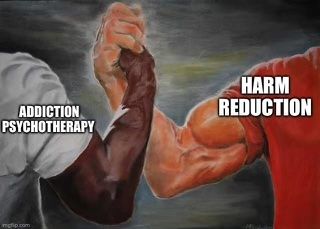Harm Reduction
Addiction Psychotherapy and Harm Reduction Go Hand In Hand
Truly person-centered care requires harm reduction.
Posted April 13, 2024 Reviewed by Gary Drevitch
Key points
- Addiction psychotherapy and harm reduction should go hand in hand.
- Practicing good addiction therapy means meeting people where they're at.
- If people knew that seeking help meant being empowered to make their own choices, more people would do it.

Addiction psychotherapy—treating problematic substance use and addictions in individual therapy—is quite effective and can be deeply rewarding. In my experience, people enjoy the individualized nature of the work and the ability to work on the things that matter to them. For therapists who work with substance use, it's imperative that we bring a person-centered lens and view each individual as unique. To do this, the philosophy of harm reduction is an excellent guide and, I'm convinced, has to form the basis of any therapist's approach.
The conventional wisdom suggests that people with substance-use issues need to "hit rock bottom" in order to change, or be willing to commit to lifelong abstinence from all drugs and alcohol in order to be successful. However, these are myths, and they probably discourage people from seeking help. Instead, offering truly person-centered care means meeting people where they're at and identifying goals that matter to that individual. Sometimes, this means abstinence, while other times it means cutting back or using more safely.
Harm Reduction Gets a Bad Rap
In the world of addiction treatment providers, harm reduction has gotten a bad rap. Some say that it's akin to encouraging our clients to use drugs, or permitting and even exacerbating problematic substance use. "The only way to achieve recovery is by giving it all up, for good," they insist. When I hear this, I point out that people don't ask my permission to get high; they're already doing it and in most cases will continue to do so. What I am trying to do is help them do so more safely, or with better awareness so that change becomes possible. And while it's true that total abstinence is often the safest path in recovery, it's not necessarily the most common or the most desirable path.
The other point that is critical to make is that our myopic view of abstinence in addiction recovery is informed by stigma and bias. We are not so militant about perfection in any other area of healthcare. Consider any number of conditions: diabetes, heart disease, depression, etc. When working with people to improve their blood sugar or mood, we encourage incremental changes, sustained over time, slowly but steadily helping to improve health and wellbeing. If there's a setback, we say, "Don't be too hard on yourself; keep at it, dust yourself off, and press on." Consider someone with Type 2 Diabetes who eats too much one weekend. They come into their doctor's office and their blood sugar levels are off and they need help getting back on track. Could you imagine that doctor telling them, "You are now back at square one. Your best thinking got you here; you must not want it bad enough." Of course not. So why do we do this in substance-use treatment?
More Awareness is Needed
I've written here before about the fact that the vast majority of people with substance use issues do not seek or receive help. I think there are two main reasons for this. The first is that most people believe their only option for addressing problematic substance use is going to "rehab." So people with mild-to-moderate problems simply wait and either get better on their own or hold out until it gets so bad they can't possibly ignore it any longer.
The other reason so few people seek help is because of the false assumption that they need to "hit rock bottom" before they do anything about it. This is a toxic and even dangerous myth that has undoubtedly caused many to suffer far longer than necessary. We must normalize seeking help early. But it's even more important that the help we offer is attractive and responsive to the unique needs of each individual.
Again, this is where harm reduction principles come in handy. A person who is just considering making a change for the first time is probably not ready to embrace lifelong abstinence—nor should they. The harm-reduction sensibility suggests that we spend time trying to understand the ins and outs of their drinking and get an idea of its meaning before making any specific recommendations. If people knew they could reach out to a professional early in the process, before they decide exactly what to do or how to move forward, a lot more might be willing to give it a try.
Addiction Psychotherapy Is Harm Reduction
To provide truly individualized, person-centered care, therapists need to embrace so-called harm reduction strategies that meet people where they're at. This is not radical; these strategies should be a key component of every therapist's toolbox. Doing so will help us reach more people and reduce more suffering.
This work is interesting and no two days are ever the same. I hope that more therapists will consider finding ways to address substance-use issues in their practice and with an emphasis on reducing harm and improving quality of life. Remember: Returning to use while still in treatment is common. In abstinence-based treatment, care is dependent upon an endorsement of total abstinence, which means that lying is not only common but even tacitly encouraged. The difference in addiction psychotherapy and harm reduction is that, here, our clients can actually talk about it.
To find a therapist, visit the Psychology Today Therapy Directory.
References
If you're a therapist interested in learning more about harm reduction and addiction psychotherapy, check out this upcoming training: Demystifying Addiction.




